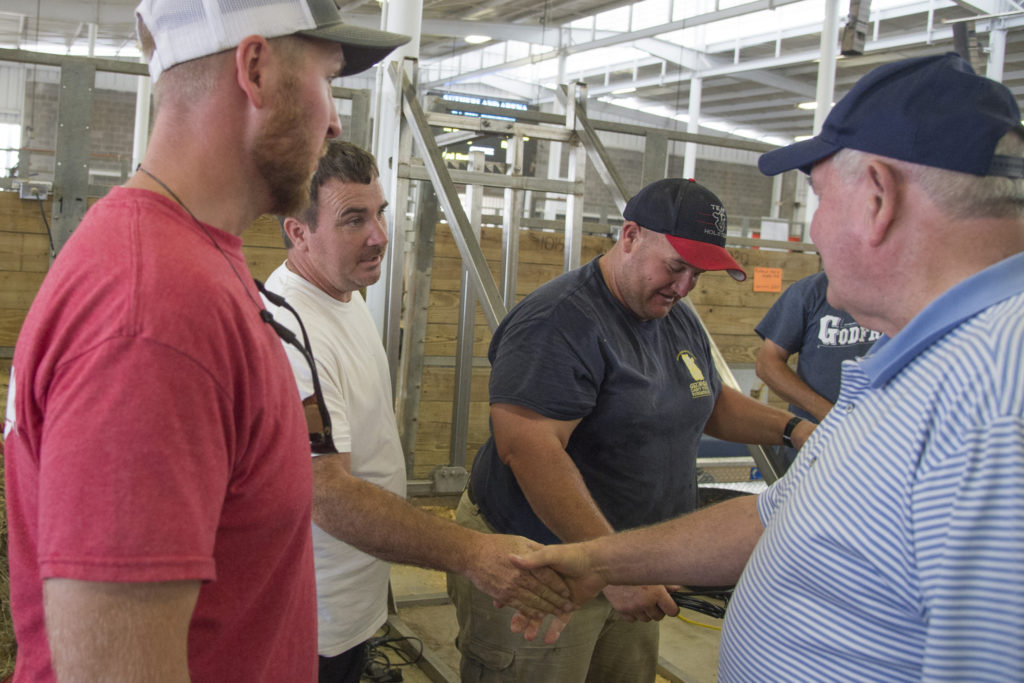New Food Economy: Wisconsin’s agriculture agent shortage heralds the end of an era for rural America
by Sam Bloch | May 29th, 2018
The University of Wisconsin Cooperative Extension has reduced its fleet, bought out ranks of rural agents, and cut the number of positions across the state. Now farmers stand to lose access to 100 years of knowledge at a time when they need it most.
Lafayette County, Wisconsin is farm country.
Blessed with fertile soil, as the local government website boasts, farming is still the county’s primary vocation, with over half of its residents working in agriculture—the highest such rate in the state. The livestock, corn, soybeans, and alfalfa hay grown there are among Wisconsin’s most valuable, and its fields among the most productive in the state.
“Anyone who has spent time in Lafayette County has likely noticed the summer wind wafting waves through the rows of corn, soybeans or alfalfa in contour with the rolling hills,” a farmland preservation plan reads, “heard the distinct hum of a grain bin’s dryer fan in the fall, or turned their nose toward the breeze to catch the faint silage as it’s fed to hungry cows on a winter morning.”
Sounds bucolic. But county officials say farmers are struggling.
Between 2007 and 2012, Lafayette, a county with just under 17,000 people, lost around 90 of its small and medium-sized farms (those under 1,000 acres). During that same five-year span, the county’s total farmland grew, with the average farm expanding by almost 40 acres. Since 2012, record harvests across the country have created an oversupply of product, and depressed prices for corn and soybeans—the backbone of Lafayette County’s farm economy. Rising costs for inputs and land aren’t helping matters, either.
Those conditions are prompting some Lafayette farmers to think about renting out their fertile cropland, which commands, by far, the highest cash rent per acre in the state.
“Land rent is a very big topic right now,” says Lori Berget, a youth educator in Lafayette County’s cooperative extension office. “A lot of producers call in and want to know: ‘What can I pay for land rent?’ And on the flip side of that, a lot of producers are calling in and asking: ‘What can I charge for land rent?’”
Berget and her co-workers are uniquely qualified to answer those questions. They’re called extension agents: Experts employed by the state’s land-grant university—a state- and federally-funded public institution founded on the study of agriculture, and dedicated to educating farming and working-class families—to bring farm research and technology to rural communities.
Systems like the University of Wisconsin Cooperative Extension—so named because of financial and programmatic responsibilities shared by federal, state, and county governments—were key to the growth of American agriculture. After the Smith-Lever Act established the system in 1914, it was extension agents who taught farmers to implement crop and livestock management practices that not only allowed them to make a living, but also to feed the world.
Today, the United States Department of Agriculture (USDA) provides all states with funding to sponsor cooperative extension offices, and there are approximately 2,900 of them across the country. Those offices include not just agriculture agents, but specialists in environmental stewardship, economic development, and youth clubs known as 4-H. In urban areas, agents focus more on horticulture—or urban gardening—and parenting services.
 At its heart, cooperative extension is an agricultural service, and thus a mostly rural phenomenon. In farm counties, agents continue to serve their communities by recommending a variety of university-tested and vetted practices, ranging from abatement of soil erosion and nutrient runoff, to livestock management and pest control. To this day, the presence of a county agent is directly linked with increased productivity and lower production costs on the farm.
At its heart, cooperative extension is an agricultural service, and thus a mostly rural phenomenon. In farm counties, agents continue to serve their communities by recommending a variety of university-tested and vetted practices, ranging from abatement of soil erosion and nutrient runoff, to livestock management and pest control. To this day, the presence of a county agent is directly linked with increased productivity and lower production costs on the farm.
And with increased productivity often comes increased risk. During the farm crisis of the 1980s, many highly leveraged family farmers were forced to sell off their land. The consolidated farms that emerged were massive operations that relied on private agronomy services and fleets of consultants and input dealers to thrive. Today, a farmer in Lafayette County, the state’s most productive for corn and soybean yields, and second-most for alfalfa hay, is unlikely to turn to an extension agent for questions about crop management. They’d sooner ask that agent for advice on finances, according to a survey conducted by UW-Extension.
But the availability of that advice isn’t a sure thing anymore.
Due to a permanent budget cut, UW-Extension has over the last two years reduced its fleet, bought out ranks of rural agents, and cut the number of positions across the state. That’s left the remaining agents with a lot more ground to cover. As part of the reorganization, they’ve been grouped into “regional clusters,” providing services to as many as five rural counties. (The state’s four most populous urban counties will keep their own agents.)
The board leadership in Lafayette County isn’t happy about the reorganization. Since the last of its two part-time specialists left the service in November, the county has contracted Gene Schriefer, a veteran agent in nearby Iowa County, as it waits for the university to send a new agent. Jack Sauer, the Lafayette board chair, has threatened to sue the state, demanding that the new agent work in his county full-time.
But even if that happens, whoever the county lands won’t have Schriefer’s know-how. As part of the reorganization, the university has lowered the bar to entry. New extension agents are now recent college graduates, and a master’s degree, or agricultural specialization, is no longer required. Nor do these agents have a path to university tenure. Instead, long-time agents say, their replacements aren’t looking at extension as a career—just an entry-level agriculture job.
Whether that new agent could provide Sauer’s farmers with trustworthy advice, when they’re considering renting the farm, remains to be seen.
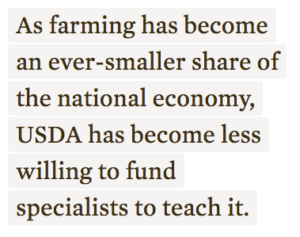 As someone who’s entrusted with university research, and hired specifically to dispense it in farm-friendly, approachable terms, the extension agent occupies a specific, mythic role in the rural imagination. Biblically, the agent would be Moses, coming down from the mountain with the word of God. In pastoral America, he is a benevolent teacher of the farm class, the local, friendly G-man, a Rockwellian figure.
As someone who’s entrusted with university research, and hired specifically to dispense it in farm-friendly, approachable terms, the extension agent occupies a specific, mythic role in the rural imagination. Biblically, the agent would be Moses, coming down from the mountain with the word of God. In pastoral America, he is a benevolent teacher of the farm class, the local, friendly G-man, a Rockwellian figure.
Think of a university researcher, who conducts double-blind studies and publishes in journals, works in a bio lab, and gene-edits or cross-breeds corn seeds. The agent is her man on the ground, planting those seeds in rural communities. The agent shares the results of those experiments during field days—public events where farmers come by a county annex office, or agricultural research station, or even a plot on another farmer’s land, to see how crops fare in different soil conditions—and may also report back to the researcher. Agents dispense state money to farmers when they use their land to test varieties. When they visit the farm, they might also spread the word about a new management technique, like no-till farming or rotational grazing.
Whether that help is still needed for farmers, when there’s online education at their fingertips, or for scientists, when there’s agronomy companies looking to purchase their research, is in doubt.
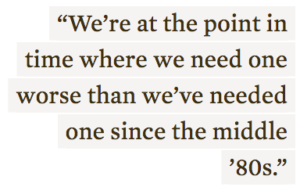 Nationwide, extension has been in decline for decades, according to Sun Ling Wang, a USDA economist. In a 2014 study, she found that the number of agents across the country fell from 11,441 to 7,974 in 30 years, with major losses in Appalachia, the Corn Belt, the Northeast, and the Southeast. Federal appropriations for cooperative extension programs also fell from $960 million to $420 million in 2015, adjusted for inflation. As farming has become an ever-smaller share of the national economy, she found, USDA has become less willing to fund specialists to teach it.
Nationwide, extension has been in decline for decades, according to Sun Ling Wang, a USDA economist. In a 2014 study, she found that the number of agents across the country fell from 11,441 to 7,974 in 30 years, with major losses in Appalachia, the Corn Belt, the Northeast, and the Southeast. Federal appropriations for cooperative extension programs also fell from $960 million to $420 million in 2015, adjusted for inflation. As farming has become an ever-smaller share of the national economy, she found, USDA has become less willing to fund specialists to teach it.
Those cuts put pressure on land-grant universities, which are facing budget issues of their own, along with counties, to take on a greater share of funding. Mahdi M. Al-Kaisi is an Iowa State University (ISU) agronomist, and part-time agent, who studied the decline of extension. Over the last decade or so, Corn Belt states like Iowa and Nebraska, along with Minnesota, Illinois, and Ohio, restructured their extension programs as regional services. In a 2015 study of Iowa’s extension program, Al-Kaisi found that funding for university research stayed about the same, but the work was increasingly funneled to private-sector agronomists, who in turn were hired by farmers.
In 2017, after two years of public-sector funding slashes by the state’s Republican Governor Scott Walker, the University of Wisconsin’s Board of Regents voted to restructure the university system by merging two-year colleges with four-year universities, and shrinking the Cooperative Extension program. Beginning in July of this year, the extension system, which has been spread throughout the state since 1965, will be reduced to another department of UW-Madison.

Extension agents, AmeriCorps volunteers, and USDA employees install hoop houses for an elementary school in Wisconsin | USDA
In response to a permanent $3.6 million budget cut—representing around 8 percent of the budget—UW-Extension developed a plan to cut 80 cooperative extension positions, and share those remaining agents across groups of three to five rural counties (the aforementioned “regional clusters”). Karl Martin, UW-Extension’s director, wouldn’t tell me how many county educator positions have been lost, but at its height, there may have been as many as 94 full- and part-time agricultural agents in the system, according to a news report. By the end of the year, Martin told me in an email, he expects to fill 64 positions across the state’s 72 county offices.
The reorganization could leave some farm counties in the lurch. In southwest Wisconsin, for example, Grant and Green counties, along with Lafayette, have each budgeted for an agriculture agent. Thus far, the university has assigned an agent to only one of those counties. Whether Lafayette will receive services—either its own agent, as Sauer wants, or splitting with another county, as the university has planned—is up in the air.
Martin added that the university is “working with our Lafayette County partners and have developed a solution that will provide Lafayette County with the agriculture educator services they have prioritized,” and pointed out that Lafayette had previously chosen to fund only part-time ag agents in the county “for over 20 years.”
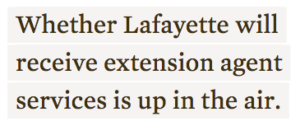 “When you mention unbiased advice, that is what you get from an ag agent,” Sauer told the Telegraph Herald. “We’re at the point in time where we need one worse than we’ve needed one since the middle ’80s.”
“When you mention unbiased advice, that is what you get from an ag agent,” Sauer told the Telegraph Herald. “We’re at the point in time where we need one worse than we’ve needed one since the middle ’80s.”
Though, since the 1980s, a lot about farming life has changed. The average age of a farmer is now 58 years old, not 50, as it was then. A generation of potential farmers have left for cities, with many now renting out their land to tenant operators. Legions of family farms have dissolved, either swallowed up by large operations, rented to young farmers who’d rather go online for ground-level knowledge, or disappeared altogether.
During cropping season in Iowa County, Schriefer, Lafayette County’s interim agent, used to spend his time driving along county roads, stopping in on farms to see how planting was going and taking stock of how high the sweet corn had grown. When droughts or floods hit the southwest part of the state, he was the local on the ground. State agriculture commissioners depended on him and agents like him to measure and record the extent of the damage.
Originally a grazing specialist with the Natural Resources Conservation Service, Schriefer has been working with livestock in the area since 1984, and has served as an extension agent since 2009. These days, Schriefer hosts meetings at places like a local bank or convention center, and invites farmers from all over the region. They run the gamut from trainings on pesticide application, to workshops on federal crop insurance, and the much-maligned dairy margin protection program. In the past, Lafayette County agents have also certified pork producers.
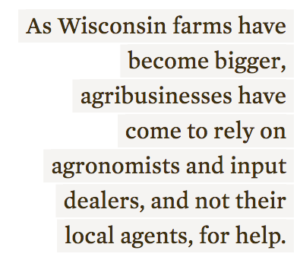 “Doing the farm calls, the traditional farm call,” Schriefer said in February, “it’s getting harder and harder to put that time in.”
“Doing the farm calls, the traditional farm call,” Schriefer said in February, “it’s getting harder and harder to put that time in.”
Schriefer knows firsthand the value of boots-on-the-ground work. During the summer of 2012, he told me, there was a “bullseye” over southwest Wisconsin. For weeks on end, temperatures regularly reached 100 degrees, leaving the soil hot and dry. Owing to the usually generous rainfall and soil moisture, many of the feed and cattle farmers in the region don’t irrigate their land. That summer, they endured a long wait for the next raincloud.
But the farmers didn’t know just how bad the conditions really were. So they did what, for decades, lots of family and mid-sized farmers did when they had a problem—called their agent to come visit. That summer, as Schriefer made more and more of those farm calls, he made some important discoveries.
When the farmers had made their first and second cuttings earlier in the season, they’d used up all the moisture in the soil, so their alfalfa fields weren’t yielding. What Schriefer was seeing instead was alfalfa growing only where roots had found moisture, in the fractures and cracks in the bedrock layer of limestone that underlaid much of the county, two feet below the soil.
“You get this kind of a checkerboard pattern across the field,” he said, “and it’s telling you exactly what’s going on.”
When Schriefer visited the farms that summer, he could feel the heat from the bare soil, which had been baking for weeks in the open sun, coming up through his shoes. He pulled out his soil thermometer, and put the probe in the ground. The gauge rose past 80, then 85, then 90 degrees, before hitting a temperature above 100 degrees. He was shocked. “Most of your soil biology dies at like, 90,” Schriefer said. “If we didn’t have canopy closure or shade on the soil, it was at a point where, basically, life doesn’t survive very well.”
Schriefer took that information to the Farm Service Agency (FSA) office in the nearby town of Dodgeville. As a result, the agency declared the drought an emergency, and almost 5,900 hay acres were released from the Conservation Resource Program (CRP). That was crucial to keeping the chattel and livestock alive. “Low quality forage, but some forage is better than no forage,” Schreifer said.
Ultimately, that forage wouldn’t be enough. After measuring the effects of the drought, and running that information up the flagpole, Schriefer was the shoulder to lean on for farmers who then had to make tough decisions. The drought meant a potentially high price for hay during the coming winter. Rather than dip into the winter feed that summer and pay the higher costs later, Schriefer advised some of the farmers to start destocking, or selling off their cattle.
“If we’re a livestock producer, which are our better stock that we’d like to maintain?” Schriefer asked. “Who’s the best? Who’s the worst? Maybe we have to look seriously at the bottom of the herd and say, ‘we can’t afford to keep you.’”
And Schreifer may have been right. His “conservative” guess on the price of hay was actually “quite low.”
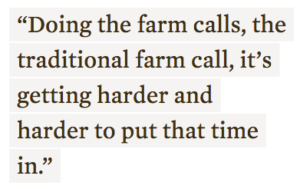 “It’s an evaluation process,” he said, “to consider, ‘what’s the least worst option?’ And doing nothing, because you can’t make a decision, could be the most costly. So you’d like to make it through it in a manner that you can live to farm another day.”
“It’s an evaluation process,” he said, “to consider, ‘what’s the least worst option?’ And doing nothing, because you can’t make a decision, could be the most costly. So you’d like to make it through it in a manner that you can live to farm another day.”
The UW-Extension system mission is for all state residents to “access university resources and engage in lifelong learning wherever they live and work.” But that’s not what’s happening on the ground, according to former and veteran agents.
“Agriculture is nothing like it was 30, 40, 50 years ago,” says Jerry Apps, a long-retired extension agent. In the 1960s, he was a livestock specialist in Green Bay. Now he writes novels about rural America’s afflictions. Cranberry Red, a recent novel, is about a former extension agent who goes to the private sector, and unknowingly pushes a poisonous chemical treatment on heartland farmers. “These huge dairy farms here in Wisconsin, some of which they have eight, 10 thousand cows—well, when I was working, 40 cows was a large number.”
In the decades since Apps retired, as Wisconsin farms have become bigger and bigger, large agribusinesses have come to rely on agronomists and input dealers, and not their local agents, for help.
George Koepp, an extension agent in Columbia County, is a former high school agriculture teacher. When he got laid off at nearby Baraboo High School, he wanted to keep his benefits package, so he got into extension. Occasionally, he takes calls from farmers in neighboring Sauk County—which, like Lafayette, lacks an agriculture agent, and has a local veterinarian serving there on an interim basis—about crops and soil health. But not too often.
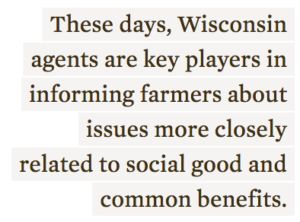 “They have probably better computer connections, so they can go out on the web and find information, or gather university information for themselves,” he says of Sauk farmers. “Or, they hire on people to help them do the job and help manage their farm that way.”
“They have probably better computer connections, so they can go out on the web and find information, or gather university information for themselves,” he says of Sauk farmers. “Or, they hire on people to help them do the job and help manage their farm that way.”
When it comes to calf management, or pasture raising, the county’s largest farms are more likely to go to an agronomist, or input dealer, than they are to someone like Koepp.
“I don’t get calls from many of the large farms around here very often at all,” Koepp says, of livestock farmers. “If they’re doing more than a thousand acres, I hardly hear from ‘em, or if they’re over 300 to 500 cows, they don’t call here looking for information. They get it through some of their other organizations that they belong to,” like the Dairy Farmers of America.
Wisconsin, of course, isn’t all large farms. Apps, the retired agent, as well as Koepp, both thought that first-generation, small-acreage farmers could stand to benefit most from advice from an extension agent. But the small-acreage farmers I talked to didn’t call their agents when they got started. Instead, they called other first-generation farmers, or sought advice, and cheap equipment, on Facebook groups.
The same could be true of family farmers. Sarah Lloyd, a Columbia County dairy farmer and Wisconsin Farmers Union coordinator, is a staunch defender of cooperative extension. To her, agents are the living, breathing manifestation of the Wisconsin Idea: the notion that the boundaries of the university are the boundaries of the state. Infamously, Governor Walker tried to remove language about the Wisconsin Idea from a proposed budget.
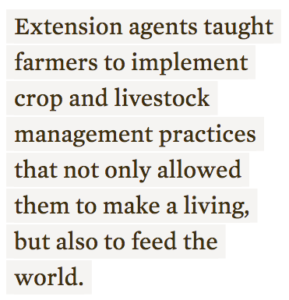 “It’s a feeling,” she says. “This public university is here for the people of the state, and we will take the knowledge of the university to the very edges of the state, to all people, to share the latest research.”
“It’s a feeling,” she says. “This public university is here for the people of the state, and we will take the knowledge of the university to the very edges of the state, to all people, to share the latest research.”
Lloyd, however, concedes that she and her husband are “in the private sector” when it comes to the actual management of her farm. Rather than work with Koepp, her agent, she seeks advice from her implement, feed, and fertilizer dealers, and pays an agronomist from her co-op for weekly farm visits and to measure feed nutrient content.
Even though extension agents are stuck, “drifting between a diminishing rural society and the urban transformation,” as one Ohio agent put it, the fact that they are not, like implement dealers, driven by a profit motivation, remains a valuable trait. These days, Wisconsin agents are key players in informing farmers about issues more closely related to social good and common benefits.
In Lafayette County, for example, agents have, in recent years, coordinated recycling programs for farmers. All over the state, they teach farmers how to safely spread manure, so that it doesn’t seep into the groundwater.
“These concerns were coming up about nitrates in the water,” says Tommy Enright, a small-acreage farmer in Portage County, and one of Lloyd’s colleagues at the Farmers Union. “So these dairy farmers decided to get proactive about it and start a producer-led watershed group, so they could get education about how to mitigate that, and maybe take on some practices that would help with the groundwater situation.”
When Enright ended up in a meeting in a barn to discuss shared solutions, guess who was there, running the show?
An extension agent.


